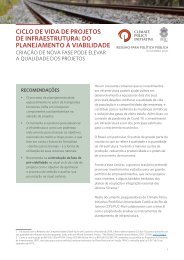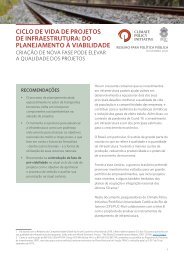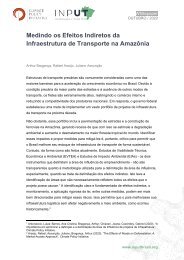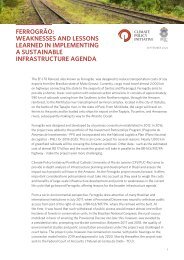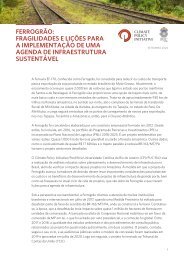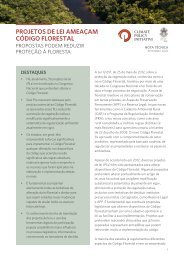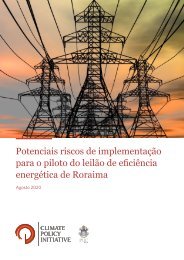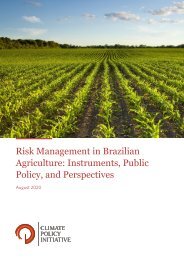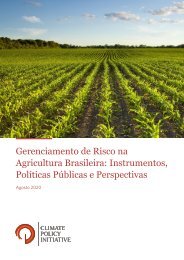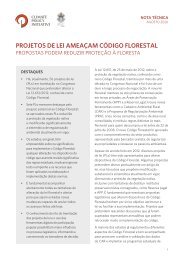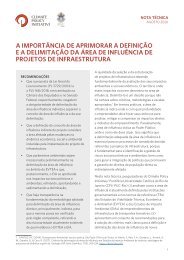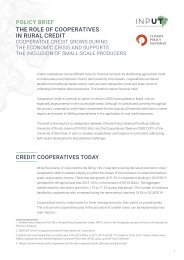The Need to Better Define and Delimit Area of Influence for Infrastructure Projects
Create successful ePaper yourself
Turn your PDF publications into a flip-book with our unique Google optimized e-Paper software.
<strong>for</strong> the definition <strong>and</strong> demarcation <strong>of</strong> areas <strong>of</strong> influence <strong>for</strong> new projects, from a perspective that<br />
explicitly incorporates where the direct <strong>and</strong> indirect effects <strong>of</strong> this type <strong>of</strong> undertaking will occur;<br />
<strong>and</strong> (iii) propose a dialogue between the EVTEA <strong>and</strong> the EIA.<br />
In Brazil, the area <strong>of</strong> influence <strong>of</strong> infrastructure projects is currently delimited in two moments:<br />
in the Feasibility Studies (Estudo de Viabilidade Técnica, Econômico e Ambiental - EVTEA), which<br />
aims <strong>to</strong> assess the economic feasibility <strong>of</strong> the project, <strong>and</strong> the Environmental Impact Assessment<br />
(Estudo de Impac<strong>to</strong> Ambiental - EIA), meant <strong>to</strong> evaluate the project’s environmental feasibility.<br />
<strong>The</strong>re is a difference in the objective <strong>and</strong> scope between these two instruments which, in itself,<br />
may lead <strong>to</strong> different delimitations <strong>of</strong> projects’ areas <strong>of</strong> influence. On the other h<strong>and</strong>, both<br />
instruments, in theory, apply <strong>to</strong> the same project, which means that it is reasonable <strong>to</strong> expect<br />
that their areas <strong>of</strong> influence should somehow be related.<br />
Within the scope <strong>of</strong> the EIA, changes <strong>to</strong> determine area <strong>of</strong> influence are currently under<br />
discussion by Brazil’s National Congress. General Environmental Licensing Bill (Legislative<br />
Bill PL 3,729/2004) <strong>and</strong> Senate Bill PLS 168/2018, both aimed at changing environmental<br />
licensing rules, restrict the concept <strong>of</strong> area <strong>of</strong> influence, proposing that it applies only <strong>to</strong> <strong>Area</strong>s<br />
<strong>of</strong> Direct <strong>Influence</strong> (Área de Influência Direta - AID), where only the direct impacts <strong>of</strong> projects<br />
are considered. In current practice, however, terms <strong>of</strong> reference <strong>for</strong> EIAs usually m<strong>and</strong>ate the<br />
establishment <strong>of</strong> both an AID <strong>and</strong> an <strong>Area</strong> <strong>of</strong> Indirect <strong>Influence</strong> (Área de Influência Indireta -<br />
AII) as parameter <strong>of</strong> study. Such proposals <strong>to</strong> restrict the concept <strong>of</strong> area <strong>of</strong> influence would,<br />
there<strong>for</strong>e, preclude the need <strong>to</strong> assess the indirect effects <strong>of</strong> building <strong>and</strong> operating the<br />
projects. As a logical consequence, they also exclude these indirect effects from future socioenvironmental<br />
mitigation <strong>and</strong> compensation programs.<br />
<strong>The</strong> a<strong>for</strong>ementioned legislative bills also draw on the concept <strong>of</strong> area <strong>of</strong> influence <strong>to</strong> determine<br />
the right <strong>to</strong> participate in the decision-making process, both by limiting public hearings<br />
exclusively <strong>to</strong> people located in the areas directly influenced by the project <strong>and</strong> by restricting the<br />
intervention <strong>of</strong> bodies <strong>and</strong> entities from outside the AIDs. 2<br />
DIFFERENT DEFINITIONS USED BY ANTT,<br />
VALEC AND CONAMA<br />
According <strong>to</strong> the Brazilian L<strong>and</strong> Transportation Regula<strong>to</strong>ry Agency (Agência Nacional de<br />
Transportes Terrestres - ANTT), an area <strong>of</strong> influence is “the part <strong>of</strong> a terri<strong>to</strong>ry where the effects <strong>of</strong><br />
the existence <strong>of</strong> a transport <strong>of</strong>fering can be perceived”. Under this definition, ANTT subdivides<br />
the area <strong>of</strong> influence in<strong>to</strong> two parts: (i) direct or nearby, i.e., an area occupied by habitual users <strong>of</strong><br />
transport facilities, <strong>and</strong> (ii) remote, where the indirect effects <strong>of</strong> a transport <strong>of</strong>fering take place. 3<br />
VALEC also classifies areas <strong>of</strong> influence as direct or indirect, but adopts a more comprehensive<br />
definition than that <strong>of</strong> ANTT. According <strong>to</strong> VALEC, an area <strong>of</strong> direct influence is composed <strong>of</strong><br />
geographical units that constitute potential hubs <strong>for</strong> the loading or passing <strong>of</strong> railroads, whereas<br />
an area <strong>of</strong> indirect influence is composed <strong>of</strong> geographical units that will be impacted by new<br />
railroad either by potentially attracting new loads or by diverting the load flow. According <strong>to</strong> the<br />
2 <strong>The</strong> intervening bodies are: FUNAI (National Indigenous Foundation), Palmares Cultural Foundation, IPHAN (National His<strong>to</strong>ric <strong>and</strong> Artistic<br />
Heritage Institute), the Ministry <strong>of</strong> Health, ICMBio (Chico Mendes Institute <strong>for</strong> Biodiversity Conservation) <strong>and</strong> INCRA (National Institute <strong>for</strong><br />
Colonization <strong>and</strong> Agrarian Re<strong>for</strong>m).<br />
3 ANTT Resolution No. 3,054 <strong>of</strong> 03/05/2009.<br />
2




